Revised: 29 September 2023
The Gospels of Matthew and Luke both contain a block of material concerning John the Baptist (Matt. 11:2-19; Luke 7:18-35). Despite insertions or deletions on the part of the author(s) of Matthew and/or Luke, their agreed upon order of three pericopae in this block of material demonstrates that both authors drew the core of this unit on John the Baptist en bloc from their common source,[1] the Anthology (Anth.):
| Matthew 11:2-19 | Luke 7:18-35 |
| Yohanan the Immerser’s Question (Matt. 11:2-6) | Yohanan the Immerser’s Question (Luke 7:18-23) |
| Yeshua’s Words about Yohanan the Immerser (Matt. 11:7-11) | Yeshua’s Words about Yohanan the Immerser (Luke 7:24-28) |
| Refusing John the Baptist (Luke 7:29-30) | |
| The Kingdom of Heaven Is Increasing (Matt. 11:12-13) | |
| John the Baptist Is Elijah (Matt. 11:14-15) | |
| Like Children Complaining (Matt. 11:16-19) | Like Children Complaining (Luke 7:31-35) |
The three pericopae common to Matthew and Luke in this unit on John the Baptist (Yohanan the Immerser’s Question; Yeshua’s Words about Yohanan the Immerser; Like Children Complaining) form the indubitable core of Anth.’s block of material on the Baptist.
The pericope we have entitled Refusing John the Baptist (Luke 7:29-30), which is absent in the parallel section of Matthew, reads like an editorial aside that the author of Luke inserted into its present context.[2] However, Refusing John the Baptist has a loose parallel in Matt. 21:31b-32, so it possible that both the authors of Matthew and Luke independently inserted a tradition about the responsiveness of toll collectors to John the Baptist compared to the unresponsiveness of Jewish leaders to the same into different locations which each author regarded as an appropriate setting.[3] Thus, with reasonable certainty we can exclude Refusing John the Baptist from Anth.’s block of material on John the Baptist.[4]
The Kingdom of Heaven Is Increasing pericope, which Matthew includes in the unit on John the Baptist, has a parallel in Luke 16:16. Whereas Matthew’s placement of The Kingdom of Heaven Is Increasing suits the context in which it appears, Luke’s version of The Kingdom of Heaven Is Increasing has no clear connection to its context. It also appears that the author of Luke copied his version of The Kingdom of Heaven Is Increasing from his second source, the First Reconstruction (FR), rather than from Anth.[5] We believe that The Kingdom of Heaven Is Increasing probably did belong to Anth.’s block of material on John the Baptist,[6] and that the author of Luke omitted it in preference for the FR version he copied in Luke 16:16.[7]
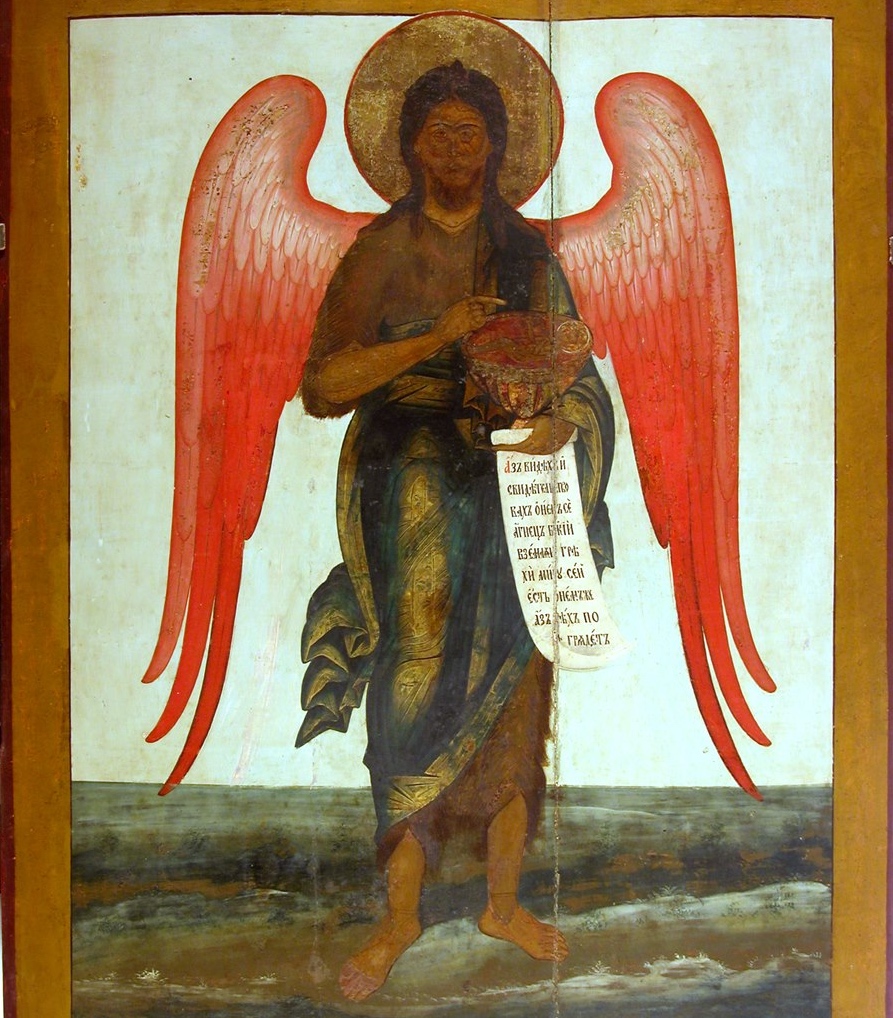
18th century icon depicting John the Baptist as an angel, based on the identification of John as the angel whom God will send mentioned in Mal. 3:1 (cf. Matt. 11:10; Luke 7:27). The halo in the icon is John’s martyr’s crown. Image courtesy of Wikimedia Commons.
John the Baptist Is Elijah (Matt. 11:14-15) is unique to the Gospel of Matthew and is probably a Matthean composition.[8] The author of Matthew likely penned Matt. 11:14 in order to bring speculations about John the Baptist’s role in salvation history to a definite conclusion. Our suspicion that he did so is strengthened by observing the Matthean redaction to the Elijah Must Come First pericope (Matt. 17:10-13 ∥ Mark 9:11-13), where the author of Matthew followed a similar procedure, adding an explicit identification of John the Baptist as Elijah (Matt. 17:13), although it is lacking in the Markan parallel, the source upon which Matthew’s version of Elijah Must Come First is based.[9] In any case, such an explicit statement about the role of John the Baptist is uncharacteristic of Jesus, who was generally evasive regarding his own unique status,[10] and therefore probably equally reticent regarding the status of others. To the explicit statement regarding John the Baptist’s role in John the Baptist Is Elijah (Matt. 11:14), the author of Matthew appended the proclamation “The one having ears, let him hear” (Matt. 11:15). The author of Matthew employed this proclamation in another redactional context (Matt. 13:43) to underscore a dramatic saying, and it is likely that the proclamation’s presence in Matt. 11:15 is redactional, too.[11] Thus, it is unlikely that John the Baptist Is Elijah was found in Anth.’s block of material on John.[12]
We therefore conjecture that at a pre-synoptic stage the block of material on John the Baptist upon which Matt. 11:2-19 and Luke 7:18-35 are based looked like this:
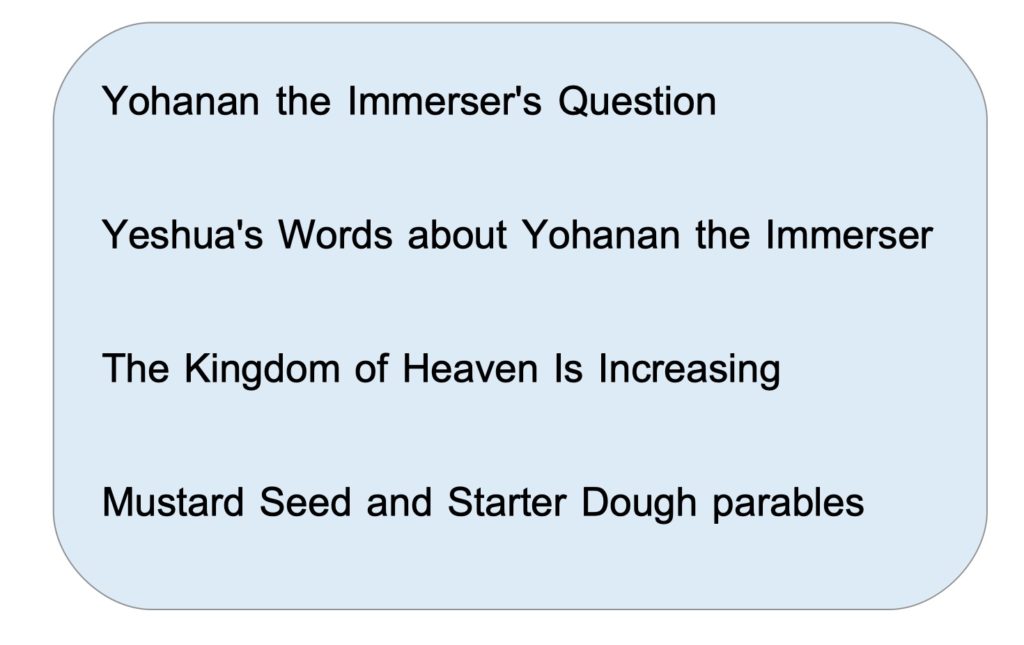
Robert Lindsey believed that Anth.’s blocks of thematically-related material were created in the following manner: The creator of Anth., whom we will refer to as the Anthologizer, was heir to a Greek translation of a Hebrew biography of Jesus (the conjectured Hebrew Life of Yeshua). In the Hebrew Life of Yeshua and in its Greek translation much of the material was presented in an integrated style, according to which a narrative incident would give rise to a teaching discourse delivered by Jesus, and to drive home the teaching’s message, the discourse would be followed up by colorful illustrations,[13] often in the form of twin parables.[14] For some reason,[15] the Anthologizer found it to be useful to split apart these narrative-sayings “complexes” into their component pieces. Whenever possible,[16] the Anthologizer detached teaching materials from narratives, and illustrations (parables and similes) from teachings. The Anthologizer then rearranged these detached units according to genre, collecting narratives into one section, teaching materials into another, and parables into a third.[17] For this reason Lindsey sometimes referred to the Anthology as the “Reorganized Scroll.”[18] Within these three main divisions the Anthologizer organized his materials into subsections according to theme.
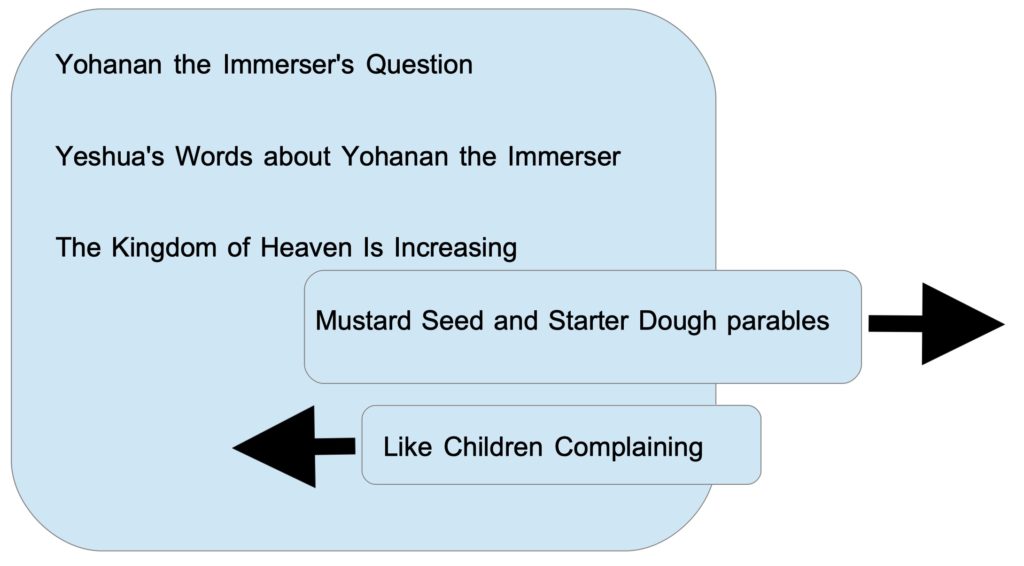
In the present instance, it appears that the Anthologizer found it either impossible or undesirable to detach the teaching portion of Yohanan the Immerser’s Question from its narrative introduction. Yeshua’s Words about Yohanan the Immerser and The Kingdom of Heaven Is Increasing were probably the continuation of Jesus’ teaching prompted by the incident of the arrival of John the Baptist’s disciples. The illustrations that likely followed up this teaching discourse were removed by the Anthologizer and placed in the parables and similes section of his work. Then, into the vacant place where the parables and similes had been, the Anthologizer tacked Like Children Complaining because it too was about John the Baptist, although it had originally belonged to a different context.[19]
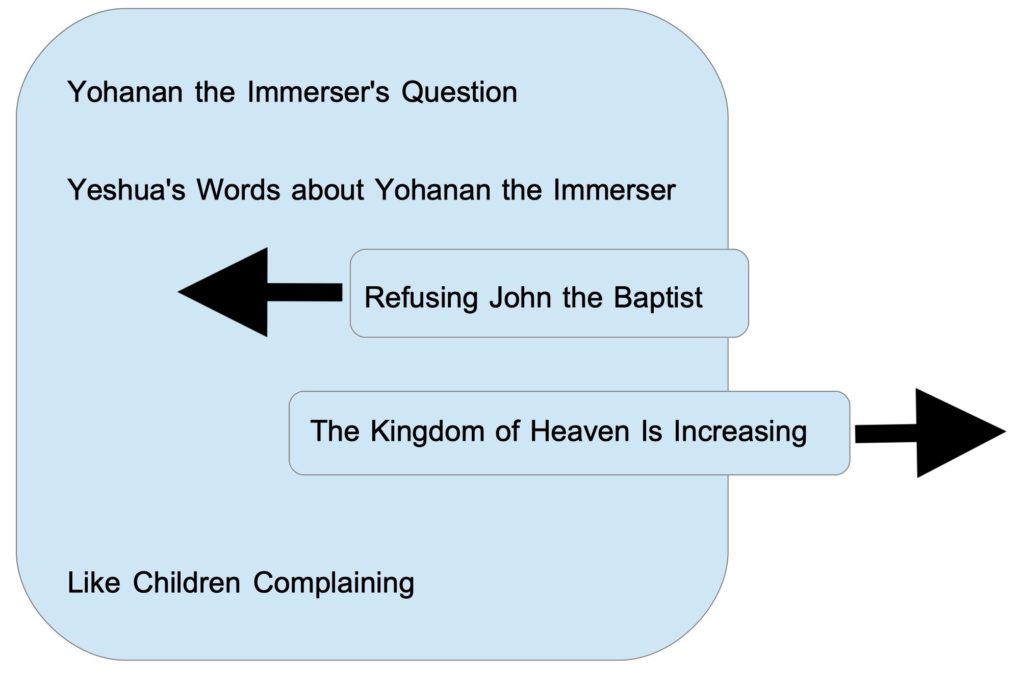
Lindsey believed that by careful analysis of the themes and vocabulary of discrete units of material in the Synoptic Gospels, it is sometimes possible to reconstruct these narrative-sayings complexes, as they appeared prior to their discomposure by the Anthologizer. With regard to the material concerning John the Baptist, Lindsey noted that the twin Mustard Seed (Matt. 13:31-32; Mark 4:30-32; Luke 13:18-19) and Starter Dough (Matt. 13:33; Luke 13:20-21) parables make for excellent illustrations of the idea of the dramatic expansion of the Kingdom of Heaven described in The Kingdom of Heaven Is Increasing (Matt. 11:12-13; Luke 16:16).[20] Building on his suggestion, we have attempted, in the LOY segments to follow, to reconstruct the “Yohanan the Immerser and the Kingdom of Heaven” complex as it existed prior to its discomposure at the hands of the Anthologizer.
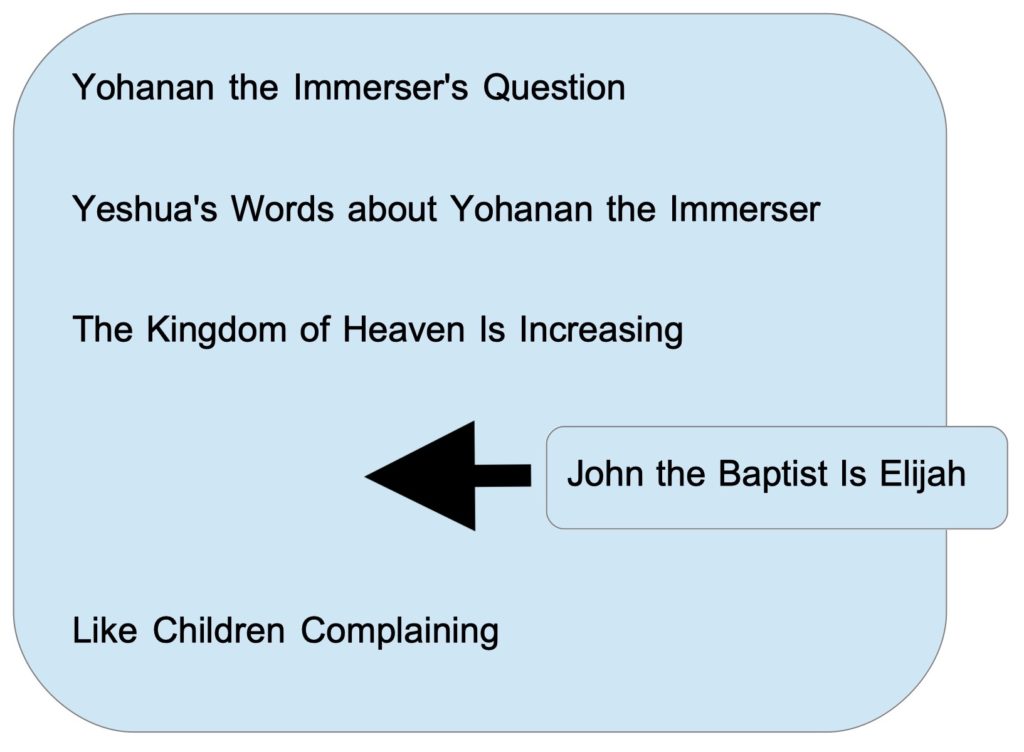
Click on the following titles to view the Reconstruction and Commentary for each pericope in the “Yohanan the Immerser and the Kingdom of Heaven” complex.
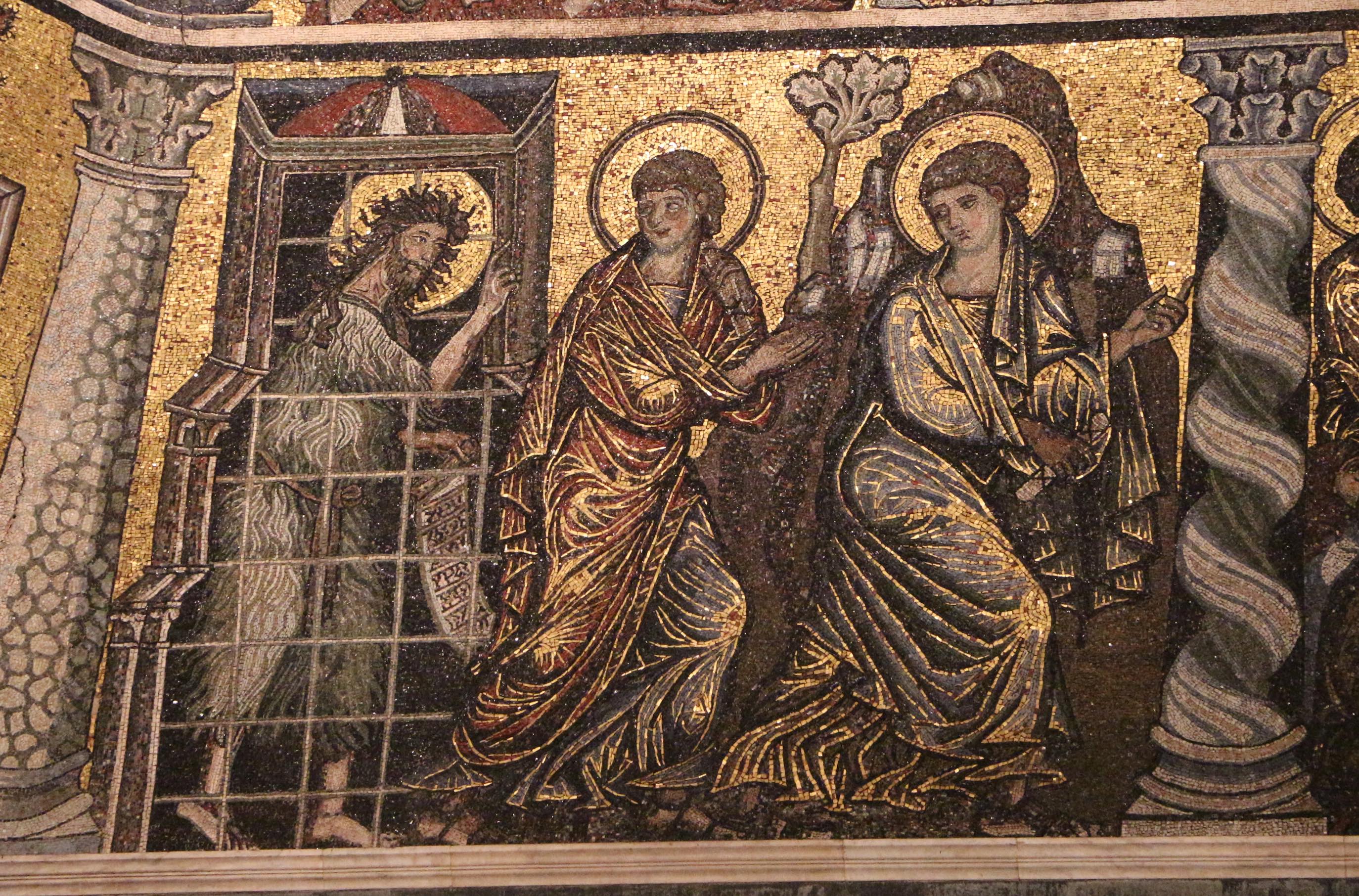 Yohanan the Immerser’s Question
Yohanan the Immerser’s Question
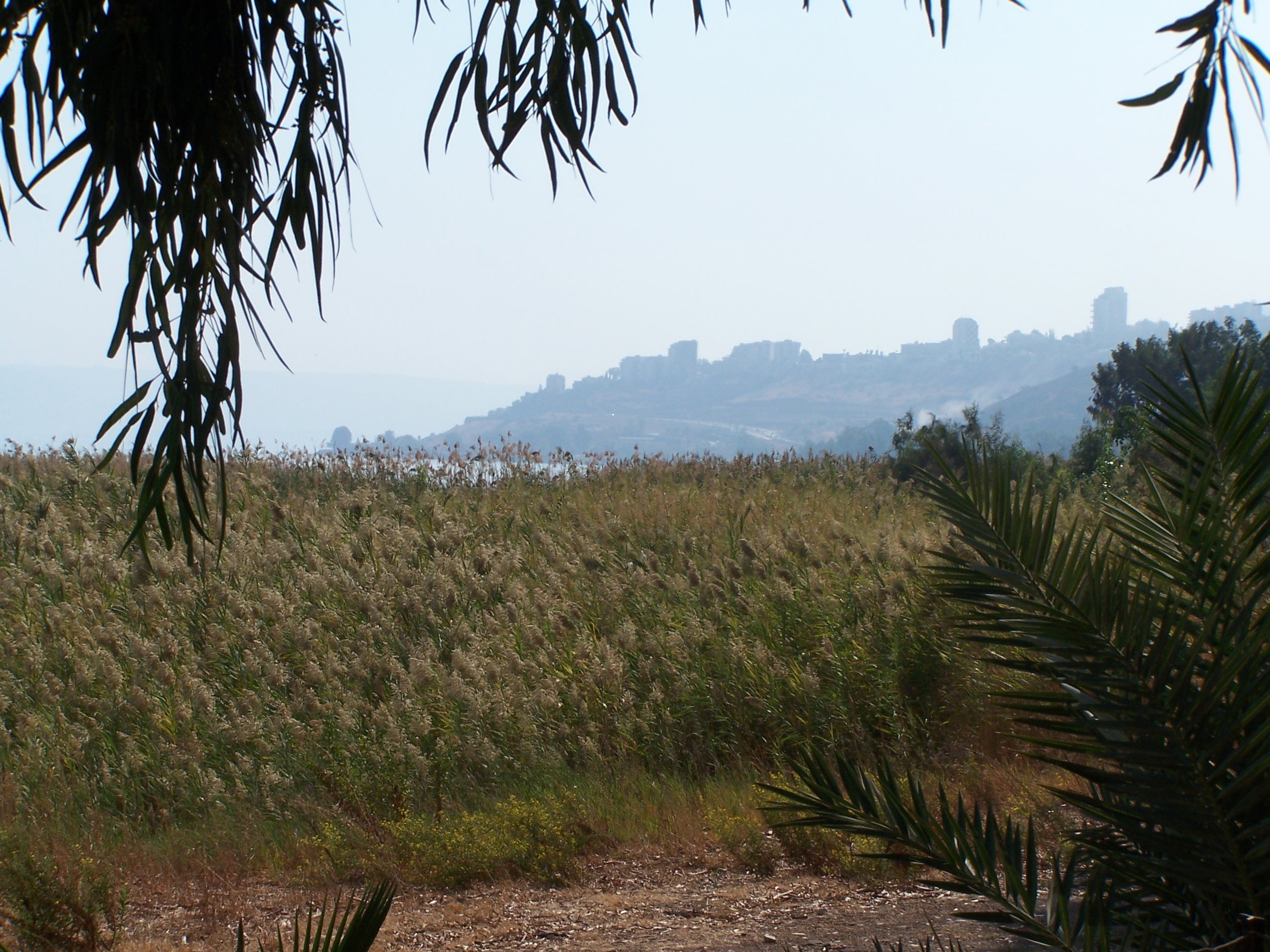 Yeshua’s Words about Yohanan the Immerser
Yeshua’s Words about Yohanan the Immerser
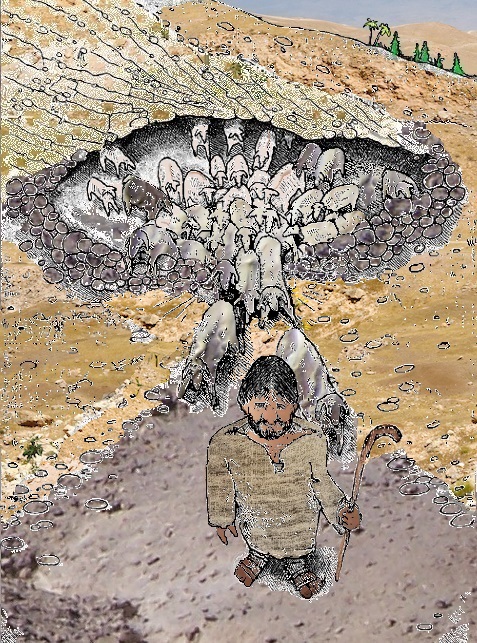 The Kingdom of Heaven Is Increasing
The Kingdom of Heaven Is Increasing
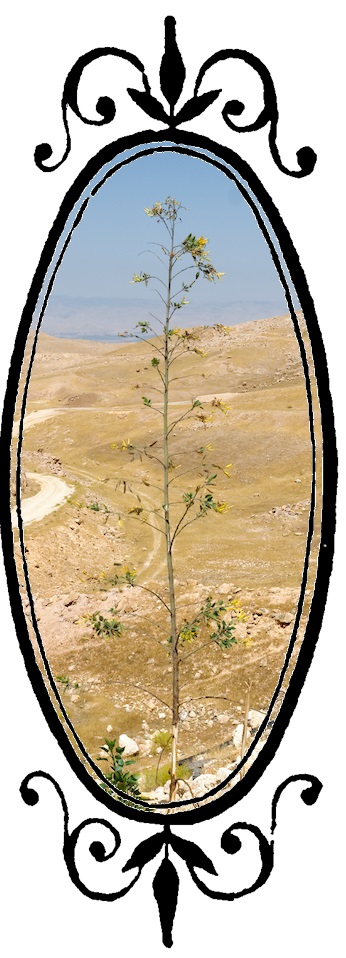 Mustard Seed and Starter Dough parables
Mustard Seed and Starter Dough parables
To demonstrate how the pieces of the “Yohanan the Immerser and the Kingdom of Heaven” complex fit together, we have assembled our paraphrases of the Hebrew reconstructions of the individual segments below. We have also assembled the Greek and Hebrew reconstructions of the entire complex and presented them following the English paraphrase.
Now, Yohanan’s disciples told him all about these things, so he picked two of his disciples and sent them to the Lord, saying, “Are you he who is coming, or must we continue waiting for someone else?” So they came to Yeshua and said, “Yohanan the Immerser sent us to ask you, ‘Are you he who is coming, or must we continue waiting for someone else?’” (Now at that time Yeshua healed many from sickness and injury and demonic oppression, and he gave many blind people the ability to see.) So Yeshua replied, “Go tell Yohanan about what you yourselves can see and hear: people who were blind are now seeing and people who were lame are now walking around. People who were impure from bearing the marks of scale disease on their bodies are now being purified and people who were deaf are now hearing sounds. And what’s more, people who were dead are now living and people who are poor are receiving the good news that the Kingdom of Heaven is here. “So my answer is this: blessed is the one who does not get tripped up trying to define me.”
As Yohanan the Immerser’s messengers departed, Yeshua asked the crowds, “What did you go out to the desert to see? A windblown reed? No? What, then, did you go out to see? Someone wearing Esau’s clothing? Of course not! People who wear such things are to be found in palaces. So what was it you went out to see? A prophet? Yes, I suspect you were looking for something even more than a prophet. Yohanan the Immerser is the one about whom Scripture says: Behold! I am sending my messenger ahead of you who will prepare your way ahead of you [Exod. 23:20; Mal. 3:1]. Indeed, I can assure you that among all human beings there has not been anyone greater than Yohanan the Immerser. Nevertheless, the least participant in God’s redeeming reign is more privileged than Yohanan.
“Since Yohanan the Immerser, and continuing into the present time, God’s redeeming reign has begun to increase, and the number of participants in his reign is on the rise. For all the prophets—and even the Torah—down to Yohanan tell of the coming redemption. But now the redemption is happening before your very eyes!”
[And Yeshua told them this parable:] “What is the Kingdom of Heaven like? Or what comparison can I make to illustrate its vitality? It’s like a mustard seed that a man planted in his garden. It germinated and grew into a tree. Birds even perched in its branches.” Then he added, “What other comparison can I make to illustrate the vitality of the Kingdom of Heaven? It’s like starter dough that a woman worked into three seahs of flour. Soon the whole batch of dough had risen.”
Greek Reconstruction
καὶ ἀπήγγειλαν Ἰωάνῃ οἱ μαθηταὶ αὐτοῦ περὶ πάντων τούτων καὶ προσκαλεσάμενος δύο τινὰς τῶν μαθητῶν αὐτοῦ ἔπεμψεν πρὸς τὸν κύριον λέγων σὺ εἶ ὁ ἐρχόμενος ἢ ἕτερον προσδοκῶμεν καὶ ἐλθόντες πρὸς αὐτὸν εἶπαν Ἰωάνης ὁ βαπτιστὴς ἀπέστειλεν ἡμᾶς πρὸς σὲ λέγων σὺ εἶ ὁ ἐρχόμενος ἢ ἕτερον προσδοκῶμεν ἐν ἐκείνῃ τῇ ὥρᾳ ἐθεράπευσεν πολλοὺς ἀπὸ νόσων καὶ μαστείγων καὶ πνευμάτων πονηρῶν καὶ τυφλοῖς πολλοῖς ἔδωκεν βλέπειν καὶ ἀποκριθεὶς Ἰησοῦς εἶπεν αὐτοῖς πορευθέντες ἀπαγγείλατε Ἰωάνῃ ἃ βλέπετε καὶ ἀκούετε τυφλοὶ ἀναβλέπουσιν καὶ χωλοὶ περιπατοῦσιν λεπροὶ καθαρίζονται καὶ κωφοὶ ἀκούουσιν καὶ νεκροὶ ἐγείρονται καὶ πτωχοὶ εὐαγγελίζονται καὶ μακάριός ἐστιν ὃς ἐὰν μὴ σκανδαλισθῇ ἐν ἐμοί
ἀπελθόντων δὲ τῶν ἀγγέλων Ἰωάνου ἤρξατο [ὁ Ἰησοῦς] λέγειν πρὸς τοὺς ὄχλους περὶ Ἰωάνου τί ἐξήλθατε εἰς τὴν ἔρημον θεάσασθαι κάλαμον ὑπὸ ἀνέμου σαλευόμενον ἀλλὰ τί ἐξήλθατε ἰδεῖν ἄνθρωπον ἐν μαλακοῖς ἠμφιεσμένον ἰδοὺ οἱ τὰ μαλακὰ φοροῦντες ἐν τοῖς οἴκοις τῶν βασιλέων εἰσίν ἀλλὰ τί ἐξήλθατε ἰδεῖν προφήτην ναὶ λέγω ὑμῖν καὶ περισσότερον προφήτου οὗτός ἐστιν περὶ οὗ γέγραπται ἰδοὺ ἐγὼ ἀποστέλλω τὸν ἄγγελόν μου πρὸ προσώπου σου ὃς κατασκευάσει τὴν ὁδόν σου ἔμπροσθέν σου ἀμὴν λέγω ὑμῖν οὐκ ἐγήγερται ἐν γεννητοῖς γυναικῶν μείζων Ἰωάνου τοῦ βαπτιστοῦ ὁ δὲ μεικρότερος ἐν τῇ βασιλείᾳ τῶν οὐρανῶν μείζων αὐτοῦ ἐστιν
ἀπὸ τῶν ἡμερῶν Ἰωάνου τοῦ βαπτιστοῦ ἕως τοῦ νῦν ἡ βασιλεία τῶν οὐρανῶν βιάζεται καὶ βιασταὶ βιάζονται εἰς αὐτήν πάντες γὰρ οἱ προφῆται καὶ ὁ νόμος ἕως Ἰωάνου ἐπροφήτευσαν
[εἶπεν δὲ πρὸς αὐτοὺς παραβολὴν λέγων] τίνι ὁμοία ἐστὶν ἡ βασιλεία τῶν οὐρανῶν καὶ τίνι ὁμοιώσω αὐτήν ὁμοία ἐστὶν κόκκῳ σινάπεως ὃν λαβὼν ἄνθρωπος ἔβαλεν εἰς κῆπον αὐτοῦ καὶ ηὔξησεν καὶ ἐγένετο εἰς δένδρον καὶ τὰ πετεινὰ τοῦ οὐρανοῦ κατεσκήνωσεν ἐν τοῖς κλάδοις αὐτοῦ καὶ πάλιν εἶπεν τίνι ὁμοιώσω τὴν βασιλείαν τῶν οὐρανῶν ὁμοία ἐστὶν ζύμῃ ἣν λαβοῦσα γυνὴ ἔκρυψεν εἰς ἀλεύρου σάτα τρία ἕως οὗ ἐζυμώθη ὅλον
Hebrew Reconstruction
וַיַּגִּידוּ לְיוֹחָנָן תַּלְמִידָיו עַל כָּל הַדְּבָרִים הָאֵלֶּה וַיִּקְרָא לִשְׁנֵי תַּלְמִידִים מִתַּלְמִידָיו וַיִּשְׁלַח אֶל הָאָדוֹן לֵאמֹר הַאַתָּה הוּא הַבָּא אוֹ לְאַחֵר נְיַחֵל וַיָּבֹאוּ אֵלָיו וַיֹּאמְרוּ יוֹחָנָן הַמַּטְבִּיל שָׁלַח אוֹתָנוּ אֵלֶיךָ לוֹמַר הַאַתָּה הוּא הַבָּא אוֹ לְאַחֵר נְיַחֵל בְּאוֹתָהּ הַשָּׁעָה רִפֵּא רַבִּים מֵחֳלָאִים וּמִמַּכּוֹת וּמֵרוּחוֹת רָעוֹת וּלְעִוְרִים רַבִּים נָתַן לִרְאוֹת וַיַּעַן יֵשׁוּעַ וַיֹּאמֶר לָהֶם לְכוּ הַגִּידוּ לְיוֹחָנָן מַה שֶּׁאַתֶּם רוֹאִים וְשׁוֹמְעִים עִוְרִים נִפְקָחִים וּפִסְחִים מִתְהַלְּכִים מְצֹרָעִים מְטוֹהָרִים וְחֵרְשִׁים שׁוֹמְעִים וּמֵתִים קָמִים וַעֲנִיִּים מִתְבַּשְּׂרִים וְאַשְׁרֵי מִי שֶׁלֹּא יִכָּשֵׁל בִּי
וְכֵיוָן שֶׁהָלְכוּ מַלְאֲכֵי יוֹחָנָן הִתְחִיל [יֵשׁוּעַ] לוֹמַר לָאֻכְלוּסִים עַל יוֹחָנָן מַה יְצָאתֶם לַמִּדְבָּר לִרְאוֹת קָנֶה מְנוּעֲנָע בָּרוּחַ אֶלָּא מַה יְצָאתֶם לִרְאוֹת אָדָם בַּחֲמוּדוֹת לָבוּשׁ הֲרֵי הָעֹטִים בַּחֲמוּדוֹת בְּבָתֵּי הַמְּלָכִים אֶלָּא מַה יְצָאתֶם לִרְאוֹת נָבִיא הֵן אֲנִי אוֹמֵר לָכֶם וְיָתֵר עַל נָבִיא זֶה הוּא שֶׁעָלָיו כָּתוּב הִנֵּה אָנֹכִי שֹׁלֵחַ מַלְאָכִי לְפָנֶיךָ אֲשֶׁר יְפַנֶּה דַּרְכְּךָ לְפָנֶיךָ אָמֵן אֲנִי אוֹמֵר לָכֶם לֹא קָם בִּילוּדֵי אִשָּׁה גָּדוֹל מִיּוֹחָנָן הַמַּטְבִּיל אַף הַקָּטֹן שֶׁבְּמַלְכוּת שָׁמַיִם גָּדוֹל מִמֶּנּוּ
מִימֵי יוֹחָנָן הַמַּטְבִּיל וְעַד עַכְשָׁיו מַלְכוּת שָׁמַיִם פּוֹרֶצֶת וּפוֹרְצִים פּוֹרְצִים בָּהּ שֶׁכָּל הַנְּבִיאִים וְאַף הַתּוֹרָה עַד יוֹחָנָן מִתְנַבְּאִים
[וַיִּמְשׁוֹל לָהֶם מָשָׁל לֵאמֹר] לְמַה דּוֹמָה מַלְכוּת שָׁמַיִם וּלְמָה אֲדַמֶּה אוֹתָהּ לְעֵין הַחַרְדָּל שֶׁנָּטַל אָדָם וְנָתַן בְּגִנָּתוֹ וְצָמַח וְהָיָה לְאִילָן וְעוֹף הַשָּׁמַיִם שָׁכְנוּ בְּבַדָּיו וְעוֹד אָמַר לְמָה אֲדַמֶּה מַלְכוּת שָׁמַיִם לִשְׂאֹר שֶׁנָּטְלָה אִשָּׁה וְטָמְנָה בְּקֶמַח שָׁלשׁ סְאִים עַד שֶׁחָמֵץ כֻּלוֹ
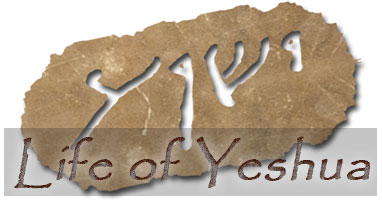 Click here to return to The Life of Yeshua: A Suggested Reconstruction main page.
_______________________________________________________
Click here to return to The Life of Yeshua: A Suggested Reconstruction main page.
_______________________________________________________
Paid Content
Premium Members and Friends of JP must be logged in to access this content: Login
If you do not have a paid subscription, please consider registering as a Premium Member starting at $10/month (paid monthly) or only $5/month (paid annually): Register
One Time Purchase Rather Than Membership
Rather than purchasing a membership subscription, you may purchase access to this single page for $1.99 USD. To purchase access we strongly encourage users to first register for a free account with JP (Register), which will make the process of accessing your purchase much simpler. Once you have registered you may login and purchase access to this page at this link:
- [1] Cf. Bundy, 166, 199; Marshall, 287; Fitzmyer, 1:662; Davies-Allison, 2:235. See also Meier, Marginal, 2:130-131. For abbreviations and bibliographical references, see “Introduction to ‘The Life of Yeshua: A Suggested Reconstruction.’” ↩
- [2] A few scholars (cf., e.g., Plummer, Luke, 205-206; Jeremias, Parables, 80; Gundry, Matt., 424) have attempted to read Luke’s version of Refusing John the Baptist as Jesus’ direct speech, but it is more natural to read these verses as an authorial aside. See Creed, 108; Bundy, 201 §111; Marshall, 297; Meier, Marginal, 2:168, 224 n. 227; Nolland, Luke, 1:342; Bovon, 1:279. ↩
- [3] It appears that in addition to secondarily incorporating this polemical statement into their respective settings, both authors also formulated it in their own words. ↩
- [4] Cf. Allen, Matt., 116; Manson, Sayings, 70; Marshall, 297; Fitzmyer, 1:270-271. ↩
- [5] That Luke’s version of The Kingdom of Heaven Is Increasing is derived from FR seems likely since, in the first place, there is a high degree of verbal disparity between the Lukan and Matthean versions of The Kingdom of Heaven Is Increasing. Lindsey usually attributed the phenomenon of high verbal disparity in Double Tradition pericopae to Luke’s use of FR, which Lindsey described as a paraphrastic epitome of Anth. In the second place, Luke’s version of The Kingdom of Heaven Is Increasing appears in a short string of pithy sayings. Lindsey attributed two other such strings of pithy sayings (Luke 8:16-18; 9:23-27) to FR. See Robert L. Lindsey, “From Luke to Mark to Matthew: A Discussion of the Sources of Markan ‘Pick-ups’ and the Use of a Basic Non-canonical Source by All the Synoptists,” under the subheading “Lukan Doublets: Sayings Doublets.” An important difference between the string of sayings in Luke 16:16-18 and those in Luke 8:16-18 and Luke 9:23-27, however, is that whereas the latter two consist entirely of Lukan Doublets, there are no doublets to the string of sayings in Luke 16:16-18. ↩
- [6] Cf. Jeremias, Theology, 46; Fitzmyer, 1:662. ↩
- [7] Cf. Bovon, 1:279. ↩
- [8] Cf. Manson, Sayings, 185; Fitzmyer, 1:663; Davies-Allison, 2:236, 258; Luz, 2:136. See also Meier, Marginal, 2:156. ↩
- [9] See Manson, Sayings, 185. ↩
- [10] Jesus customarily referred to his own unique status by means of hints and scriptural allusions. ↩
- [11] See Davies-Allison, 2:259; Nolland, Matt., 459. ↩
- [12] Cf. Manson, Sayings, 68. ↩
- [13] See Lindsey, “From Luke to Mark to Matthew,” under the subheading “Restoration of Narrative-Sayings Complexes”; idem, TJS, 38-39, 42-43. ↩
- [14] For a discussion of Jesus’ use of twin illustrations, see Robert L. Lindsey, “Jesus’ Twin Parables.” ↩
- [15] Even today, modern readers often like to separate Jesus’ teachings from their narrative contexts, as we see in red-letter editions of the Gospels. Likewise, it is not uncommon to find collections of Jesus’ parables which are made for different types of audiences (children, students and scholars). ↩
- [16] Sometimes the Anthologizer found it impossible to divorce a saying from its narrative introduction without destroying its meaning, in which case he allowed the narrative to remain joined to the teaching. Apparently, the Anthologizer had fewer qualms about separating parables from the teachings they originally illustrated. ↩
- [17] See Lindsey, TJS, 39. ↩
- [18] See Lindsey, TJS, 36. ↩
- [19] Lindsey (LHNS, 53; JRL, 161) suggested that Like Children Complaining may have been the continuation of Jesus’ response to the question about why he and his disciples did not fast. Cf. Tomson, If This Be, 139; R. Steven Notley, “Luke 5:35: ‘When the Bridegroom is taken Away’—Anticipation of the Destruction of the Second Temple,” in The Gospels in First-Century Judaea (ed. R. Steven Notley and Jeffrey Paul García; Leiden: Brill, 2006), 107-121, esp. 110.
The application of the verb ἔρχεσθαι (erchesthai, “to come”) to John the Baptist and to Jesus in Like Children Complaining (Matt. 11:18, 19 ∥ Luke 7:33, 34) may have been a significant factor in the Anthologizer’s decision to append Like Children Complaining to the end of the discourse on John the Baptist, as the discourse had been prompted by the Baptist’s query whether Jesus was ὁ ἐρχόμενος (ho erchomenos, “he who is coming”; Matt. 11:3 ∥ Luke 7:19). See Richard A. Edwards, “Matthew’s Use of Q in Chapter 11,” in Logia Les Paroles de Jésus—The Sayings of Jesus: Mémorial Joseph Coppens (ed. Joël Delobel; Leuven: Leuven University Press, 1982), 257-275, esp. 267. ↩ - [20] See Lindsey, JRL, 76-77. ↩































































































